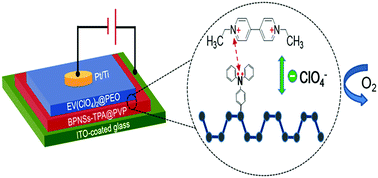Anti-oxidative passivation and electrochemical activation of black phosphorus via covalent functionalization and its nonvolatile memory application†
Abstract
As a novel layered semiconductor that can bridge the energy band and carrier mobility gaps between graphene and transition metal dichalcogenides, black phosphorus (BP) has broad prospects in optoelectronics and nanoelectronics. Nevertheless, the contradiction between excellent semiconducting properties and easy oxidation under ambient conditions is difficult to reconcile. Herein, the first demonstration of the protection and regulation of BP by introducing redox-active moieties of triphenylamine (TPA) is reported. The prepared BP nanosheets grafted covalently with TPA molecules (BPNSs–TPA) exhibit excellent anti-oxidative capability and electrochemical activity. As a proof of concept, BPNSs–TPA are successfully used to construct a nonvolatile redox-based resistive switching memory, showing good working stability and durability. Meanwhile, potentiation and depression characteristics of a biological synapse are well emulated within the memory cell. These demonstrations could provide a powerful way to protect and functionalize BP through organic small molecules, which is of great significance for the application of BP in memory and neuromorphic devices.



 Please wait while we load your content...
Please wait while we load your content...